Fault-Source-Based Probabilistic Seismic Hazard and Risk Analysis for Victoria, British Columbia, Canada: A Case of the Leech River Valley Fault and Devil’s Mountain Fault System
Abstract
1. Introduction
2. Study Area
2.1. Leech River Valley Fault and Devil’s Mountain Fault
2.2. Residential Wooden Houses in Victoria
3. Methodology
3.1. Seismic Hazard Model for the Leech River Valley Fault and Devil’s Mountain Fault System
3.1.1. Fault Rupture Model
3.1.2. Earthquake Magnitude Model
3.1.3. Ground-Motion Model
3.1.4. Logic Tree for Uncertainty Characterization
3.2. Exposure Model for Residential Wooden Buildings in Victoria
3.3. Seismic Fragility Model and Loss Estimation for Residential Wooden Buildings in Victoria
4. Sensitivity of Fault-Source-Based Probabilistic Seismic Hazard Analysis of the Leech River Valley Fault and Devil’s Mountain Fault System
4.1. Effects of Rupture Cases and Magnitude Models on Magnitude–Recurrence Relationships
4.2. Base PSHA Results
4.3. Sensitivity to Slip Rate, b Value, and Mmax Shift
4.4. Sensitivity to Logic-Tree Weight Variations for Segmented Versus Synchronous Rupture Scenarios and Characteristic Versus Exponential Magnitude Models
5. Sensitivity of Fault-Source-Based Probabilistic Seismic Risk Analysis of the Leech River Valley Fault and Devil’s Mountain Fault System
5.1. Base Case
5.2. Sensitivity to Slip Rate, b Value, and Mmax Shift
5.3. Sensitivity to Logic-Tree Weight Variations for Segmented Versus Synchronous Rupture Models and Characteristic Versus Exponential Magnitude Models
6. Conclusions
- For short-period seismic intensity measures, the seismic hazard contributions from the LRVF-DMF system are not negligible, especially in the low annual probability of exceedance range, and these events should be considered as critical earthquake scenarios for the earthquake impact assessments and disaster preparedness purposes. On the other hand, for long-period seismic intensity measures, the most dominant source is the Cascadia megathrust interface zone, followed by the LRVF-DMF system.
- Overall, among the examined parameters, the influence of the slip rate is the most significant and thus its uncertainty characterization needs to be scrutinized further in conducting a fault-source-based PSHA study. This conclusion is also applicable to the sensitivity analysis results based on the portfolio seismic loss.
- The selections of the segmented versus synchronous rupture scenarios as well as the characteristic versus exponential magnitude models can have pronounced effects on both seismic hazard and risk assessments. The sensitivity analysis results can inform how influential these critical uncertainties are and thus such investigations should be performed.
- The consideration of the LRVF-DMF system results in a 10% to 30% increase in the city-wide building portfolio seismic loss in Victoria. In light of this significant risk potential, although the LRVF-DMF system is not the major contributor of the seismic hazard at the annual probability of exceedance of 4 × 10−4 (or 2475-year return period), potential ruptures from this fault source should be considered as one of the critical earthquake scenarios in assessing the adequacy of seismic mitigation and recovery plans that are currently in place for communities in southern Vancouver Island. For such purposes, the integrated use of the advanced seismic hazard and risk models should be promoted at all levels of earthquake risk management in both public and private sectors.
Author Contributions
Funding
Institutional Review Board Statement
Informed Consent Statement
Data Availability Statement
Conflicts of Interest
References
- Goulet, C.A.; Haselton, C.B.; Mitrani-Reiser, J.; Beck, J.L.; Deierlein, G.G.; Porter, K.A.; Stewart, J.P. Evaluation of the seismic performance of a code-conforming reinforced-concrete frame building—From seismic hazard to collapse safety and economic losses. Earthq. Eng. Struct. Dyn. 2007, 36, 1973–1997. [Google Scholar] [CrossRef]
- Liel, A.B.; Deierlein, G.G. Cost-benefit evaluation of seismic mitigation alternatives for older reinforced concrete frame buildings. Earthq. Spectra 2013, 29, 1391–1411. [Google Scholar] [CrossRef]
- Mitchell-Wallace, K.; Jones, M.; Hillier, J.; Foote, M. Natural Catastrophe Risk Management and Modelling: A Practitioner’s Guide; Wiley-Blackwell: Chichester, UK, 2017; p. 536. [Google Scholar]
- Shokrabadi, M.; Burton, H.V. Regional short-term and long-term risk and loss assessment under sequential seismic events. Eng. Struct. 2019, 185, 366–376. [Google Scholar] [CrossRef]
- Hyndman, R.D.; Rogers, G.C. Great earthquakes on Canada’s west coast: A review. Can. J. Earth Sci. 2010, 47, 801–820. [Google Scholar] [CrossRef]
- Onur, T.; Ventura, C.E.; Finn, W.D.L. Regional seismic risk in British Columbia—Damage and loss distribution in Victoria and Vancouver. Can. J. Civ. Eng. 2005, 32, 361–371. [Google Scholar] [CrossRef]
- Ventura, C.E.; Finn, W.D.L.; Onur, T.; Blanquera, A.; Rezai, M. Regional seismic risk in British Columbia: Classification of buildings and development of damage probability functions. Can. J. Civ. Eng. 2005, 32, 372–387. [Google Scholar] [CrossRef]
- AIR Worldwide. Study of Impact and the Insurance and Economic Cost of a Major Earthquake in British Columbia and Ontario/Québec; Insurance Bureau of Canada: Toronto, ON, Canada, 2013; p. 345. [Google Scholar]
- Goda, K.; Zhang, L.; Tesfamariam, S. Portfolio seismic loss estimation and risk-based critical scenarios for residential wooden houses in Victoria, British Columbia, Canada. Risk Anal. 2021. [Google Scholar] [CrossRef]
- Halchuk, S.; Allen, T.I.; Adams, J.; Rogers, G.C. Fifth generation seismic hazard model input files as proposed to produce values for the 2015 National Building Code of Canada. Geol. Surv. Can. Open File 2014, 7576, 15. [Google Scholar]
- Goda, K. Nationwide earthquake risk model for wood-frame houses in Canada. Front. Built Environ. 2019, 5, 128. [Google Scholar] [CrossRef]
- Morell, K.D.; Regalla, C.; Amos, C.; Bennett, S.; Leonard, L.J.; Graham, A.; Reedy, T.; Levson, V.; Telka, A. Holocene surface rupture history of an active forearc fault redefines seismic hazard in southwestern British Columbia, Canada. Geophys. Res. Lett. 2018, 45, 11605–11611. [Google Scholar] [CrossRef]
- Li, G.; Liu, Y.; Regalla, C.; Morell, K.D. Seismicity relocation and fault structure near the Leech River fault zone, southern Vancouver Island. J. Geophys. Res. Solid Earth 2018, 123, 2841–2855. [Google Scholar] [CrossRef]
- Barrie, J.V.; Greene, H.G. The Devils Mountain Fault zone: An active Cascadia upper plate zone of deformation, Pacific Northwest of North America. Sediment. Geol. 2018, 364, 228–241. [Google Scholar] [CrossRef]
- Halchuk, S.; Allen, T.I.; Adams, J.; Onur, T. Contribution of the Leech River Valley—Devil’s Mountain Fault system to seismic hazard in Victoria, British Columbia. In Proceedings of the 12th Canadian Conference on Earthquake Engineering, Quebec City, QC, Canada, 17–20 June 2019. Paper 192-WGm8-169. [Google Scholar]
- Kukovica, J.; Ghofrani, H.; Molnar, S.; Assatourians, K. Probabilistic seismic hazard analysis of Victoria, British Columbia: Considering an active fault zone in the nearby Leech River Valley. Bull. Seismol. Soc. Am. 2019, 109, 2050–2062. [Google Scholar]
- Youngs, R.R.; Coppersmith, K.J. Implications of fault slip rates and earthquake recurrence models to probabilistic seismic hazard estimates. Bull. Seismol. Soc. Am. 1985, 75, 939–964. [Google Scholar] [CrossRef]
- Mazzotti, S.; Leonard, L.J.; Cassidy, J.F.; Rogers, G.C.; Halchuk, S. Seismic hazard in western Canada from GPS strain rates versus earthquake catalog. J. Geophys. Res. Solid Earth 2011, 116, B12310. [Google Scholar] [CrossRef]
- Johnson, S.Y.; Dadisman, S.V.; Mosher, D.C.; Blakely, R.J.; Childs, J.R. Active Tectonics of the Devils Mountain Fault and Related Structures, Northern Puget Lowland and Eastern Strait of Juan de Fuca Region, Pacific Northwest; Professional Paper 1643; United States Geological Survey: Denver, CO, USA, 2001; p. 45.
- Monahan, P.A.; Levson, V.M.; Henderson, P.; Sy, A. Relative Amplification of Ground Motion Hazard Map of Greater Victoria; Geoscience Map 2000-3, Sheet 3B; British Columbia Geological Survey; Ministry of Energy and Mines: Victoria, BC, Canada, 2000.
- Goda, K. Probabilistic characterization of seismic deformation due to tectonic fault movements. Soil Dyn. Earthq. Eng. 2017, 100, 316–329. [Google Scholar] [CrossRef]
- Thingbaijam, K.K.S.; Mai, P.M.; Goda, K. New empirical earthquake source scaling laws. Bull. Seismol. Soc. Am. 2017, 107, 2225–2246. [Google Scholar] [CrossRef]
- Convertito, V.; Emolo, A.; Zollo, A. Seismic-hazard assessment for a characteristic earthquake scenario: An integrated probabilistic–deterministic method. Bull. Seismol. Soc. Am. 2006, 96, 377–391. [Google Scholar] [CrossRef]
- Page, M.; Felzer, K. Southern San Andreas Fault seismicity is consistent with the Gutenberg–Richter magnitude–frequency distribution. Bull. Seismol. Soc. Am. 2015, 105, 2070–2080. [Google Scholar] [CrossRef]
- Stirling, M.; Gerstenberger, M. Applicability of the Gutenberg–Richter relation for major active faults in New Zealand. Bull. Seismol. Soc. Am. 2018, 108, 718–728. [Google Scholar] [CrossRef]
- Atkinson, G.M.; Adams, J. Ground motion prediction equations for application to the 2015 Canadian national seismic hazard maps. Can. J. Civ. Eng. 2013, 40, 988–998. [Google Scholar] [CrossRef]
- Humar, J. Background to some of the seismic design provisions of the 2015 National Building Code of Canada. Can. J. Civ. Eng. 2015, 42, 940–952. [Google Scholar] [CrossRef]
- Goda, K.; Atkinson, G.M. Intraevent spatial correlation of ground-motion parameters using SK-net data. Bull. Seismol. Soc. Am. 2010, 100, 3055–3067. [Google Scholar] [CrossRef]
- Wald, D.J.; Allen, T.I. Topographic slope as a proxy for seismic site conditions and amplification. Bull. Seismol. Soc. Am. 2007, 97, 1379–1395. [Google Scholar] [CrossRef]
- Folz, B.; Filiatrault, A. Seismic analysis of woodframe structures. I: Model formulation. J. Struct. Eng. 2004, 130, 1353–1360. [Google Scholar]
- White, T.W.; Ventura, C.E. Seismic Performance of Wood-Frame Residential Construction in British Columbia-Technical Report; Earthquake Eng. Research Facility Report No. 06-03; University of British Columbia: Vancouver, BC, Canada, 2006. [Google Scholar]
- Mitchell, D.; Paultre, P.; Tinawi, R.; Saatciouglu, M.; Tremlay, R.; Elwood, K.; DeVall, R. Evolution of seismic design provisions in the National building code of Canada. Can. J. Civ. Eng. 2010, 37, 1157–1170. [Google Scholar] [CrossRef]
- Vamvatsikos, D.; Cornell, C.A. Incremental dynamic analysis. Earthq. Eng. Struct. Dyn. 2002, 31, 491–514. [Google Scholar] [CrossRef]
- Wesson, R.L.; Perkins, D.M.; Leyendecker, E.V.; Roth, R.J., Jr.; Petersen, M.D. Losses to single-family housing from ground motions in the 1994 Northridge, California, earthquake. Earthq. Spectra 2004, 20, 1021–1045. [Google Scholar] [CrossRef]
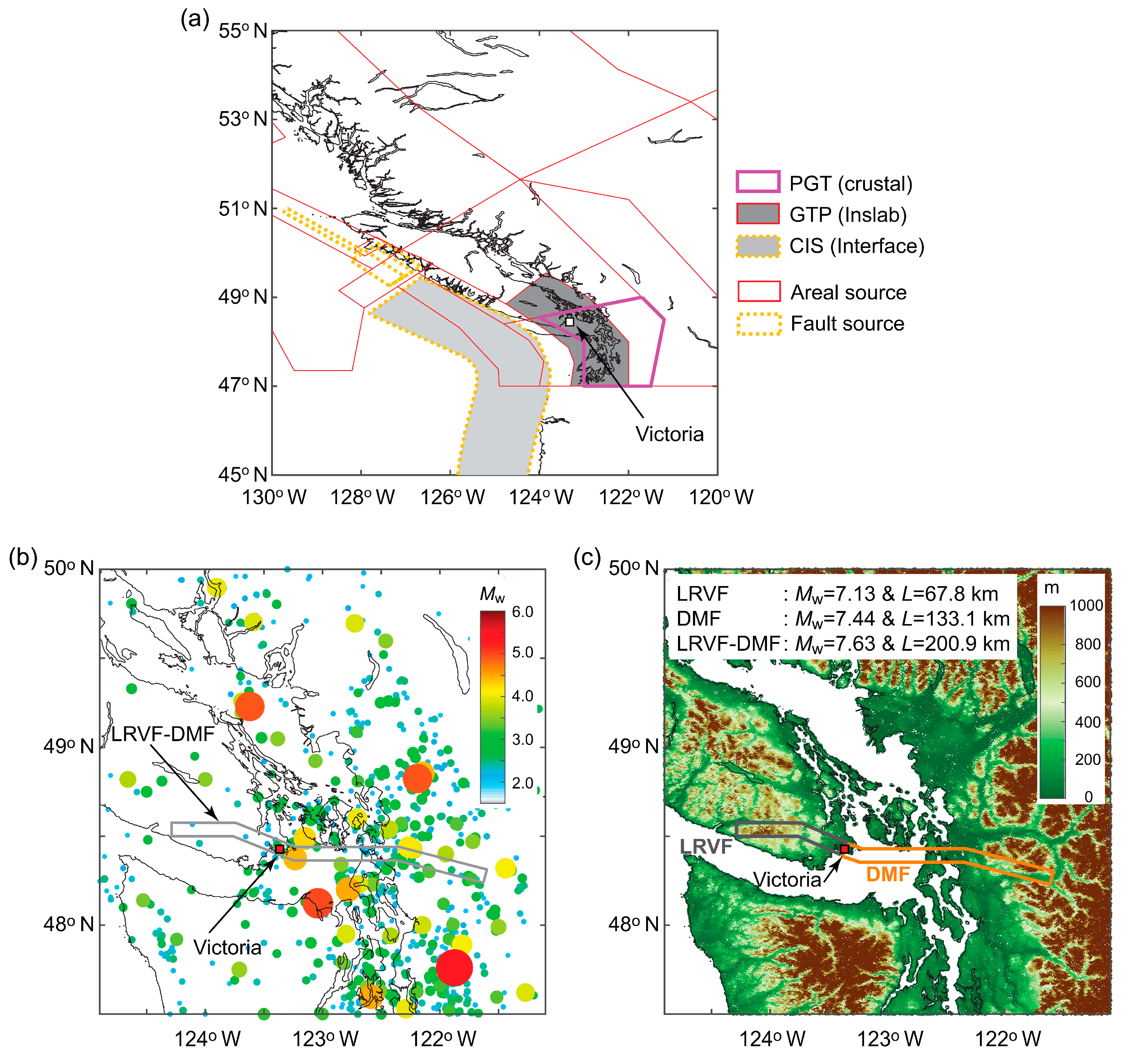

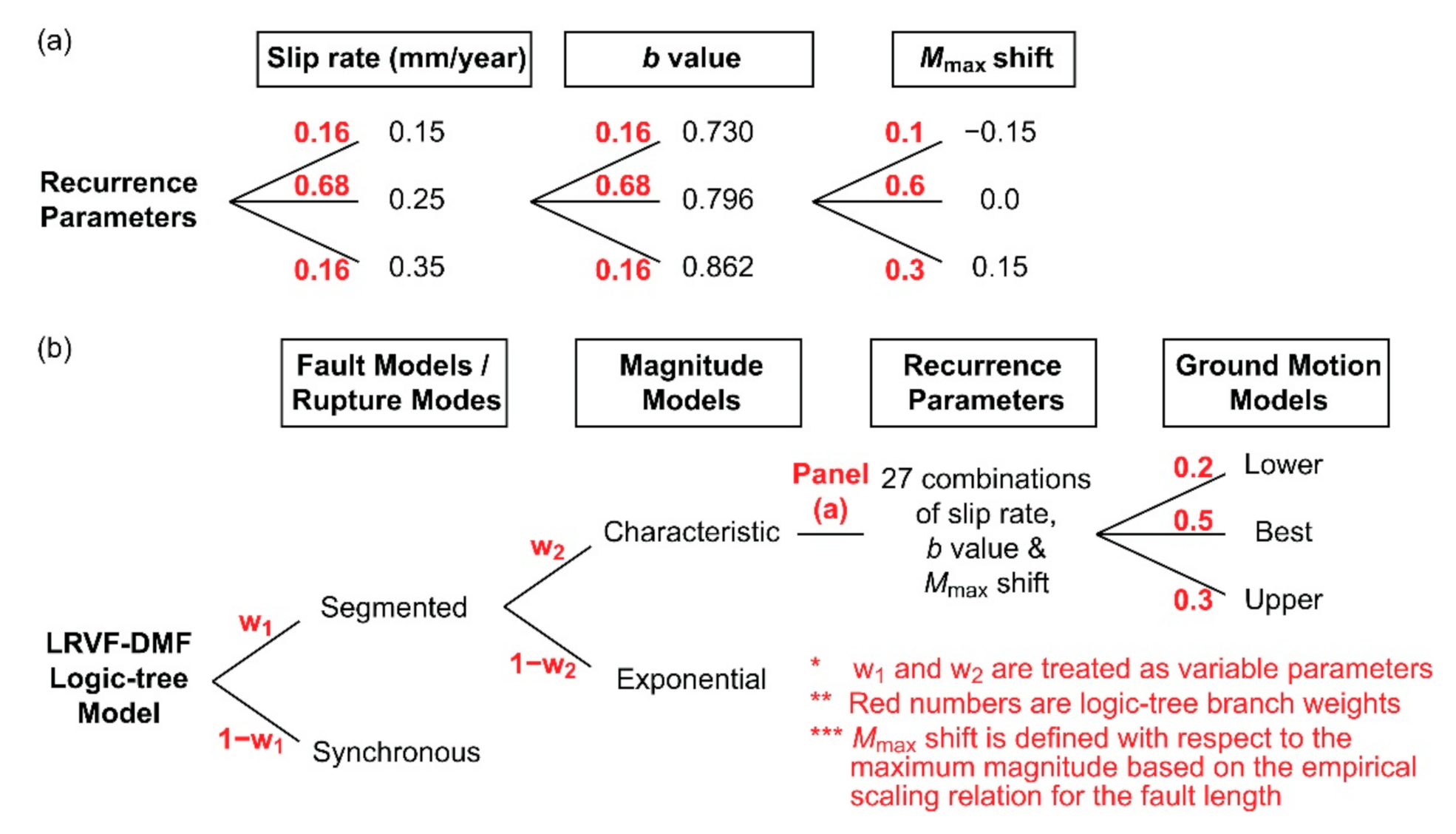
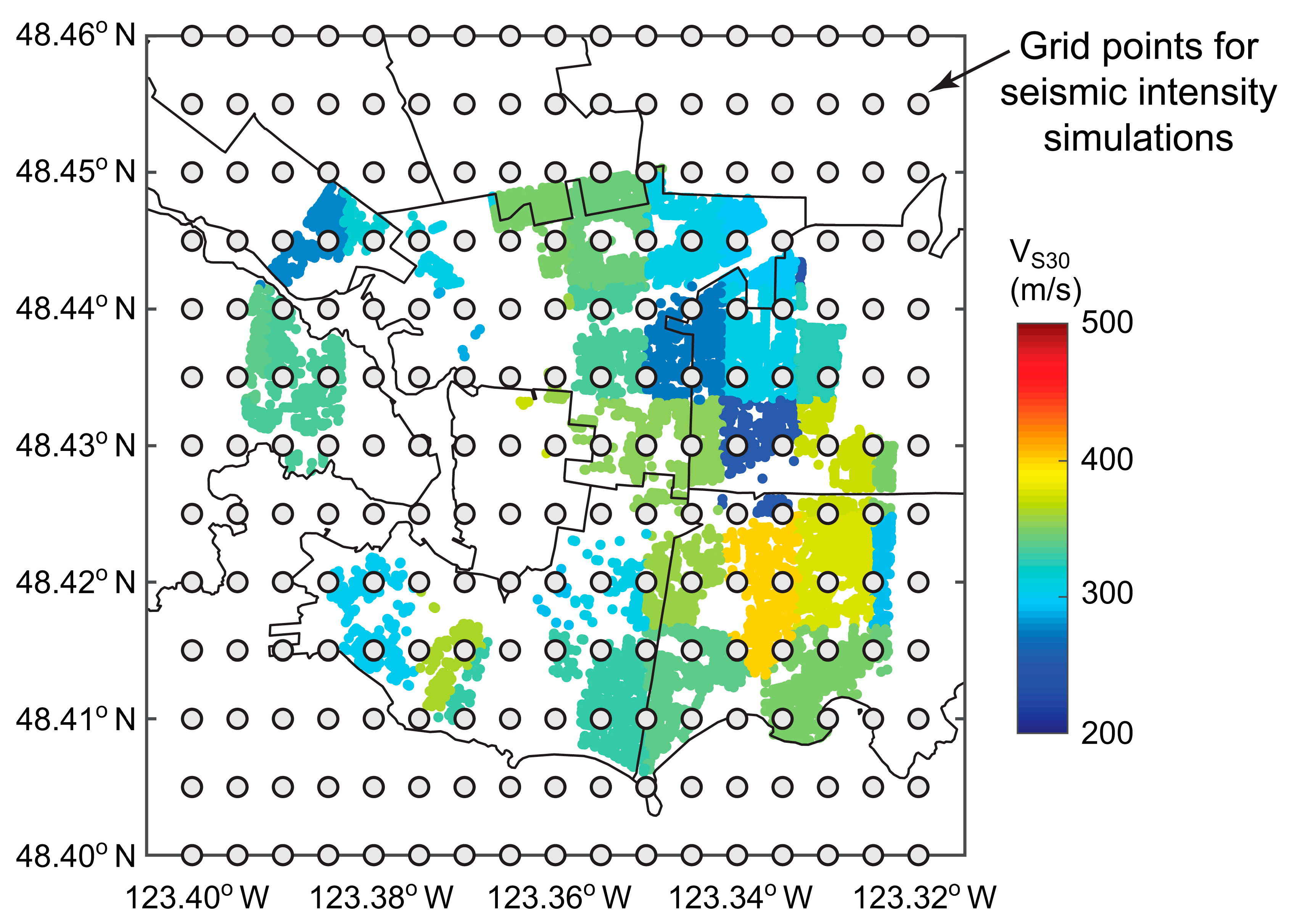
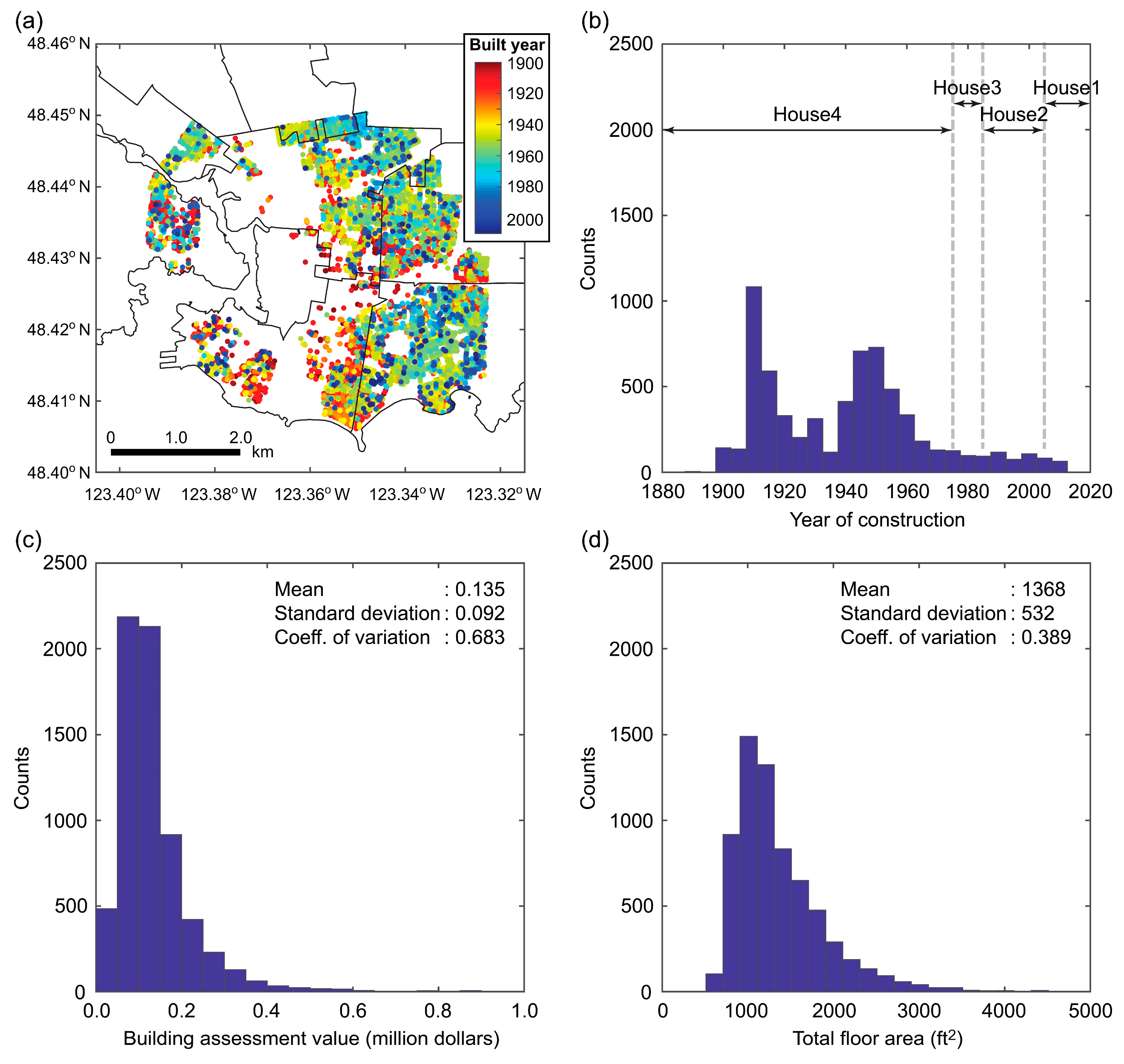
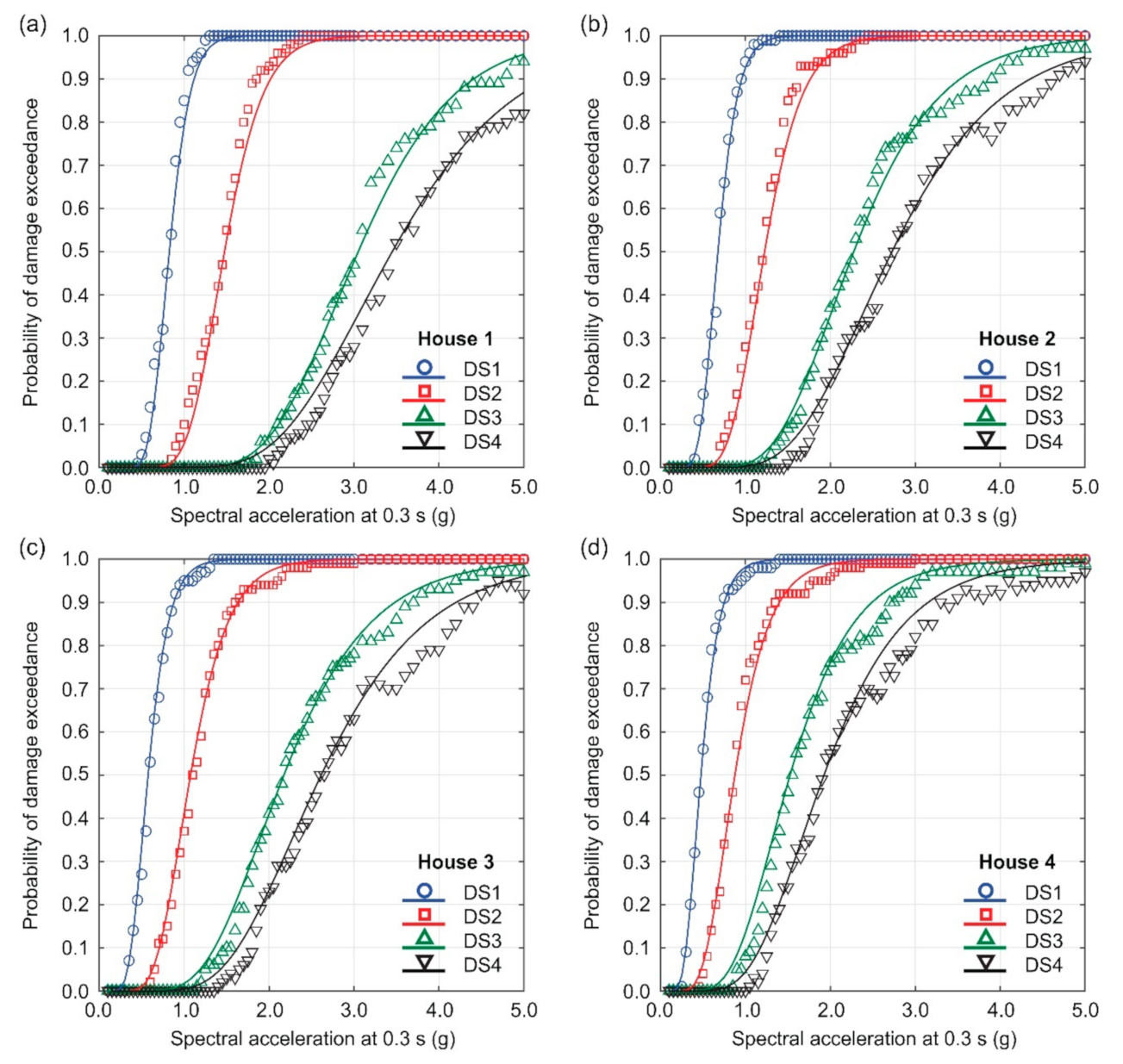

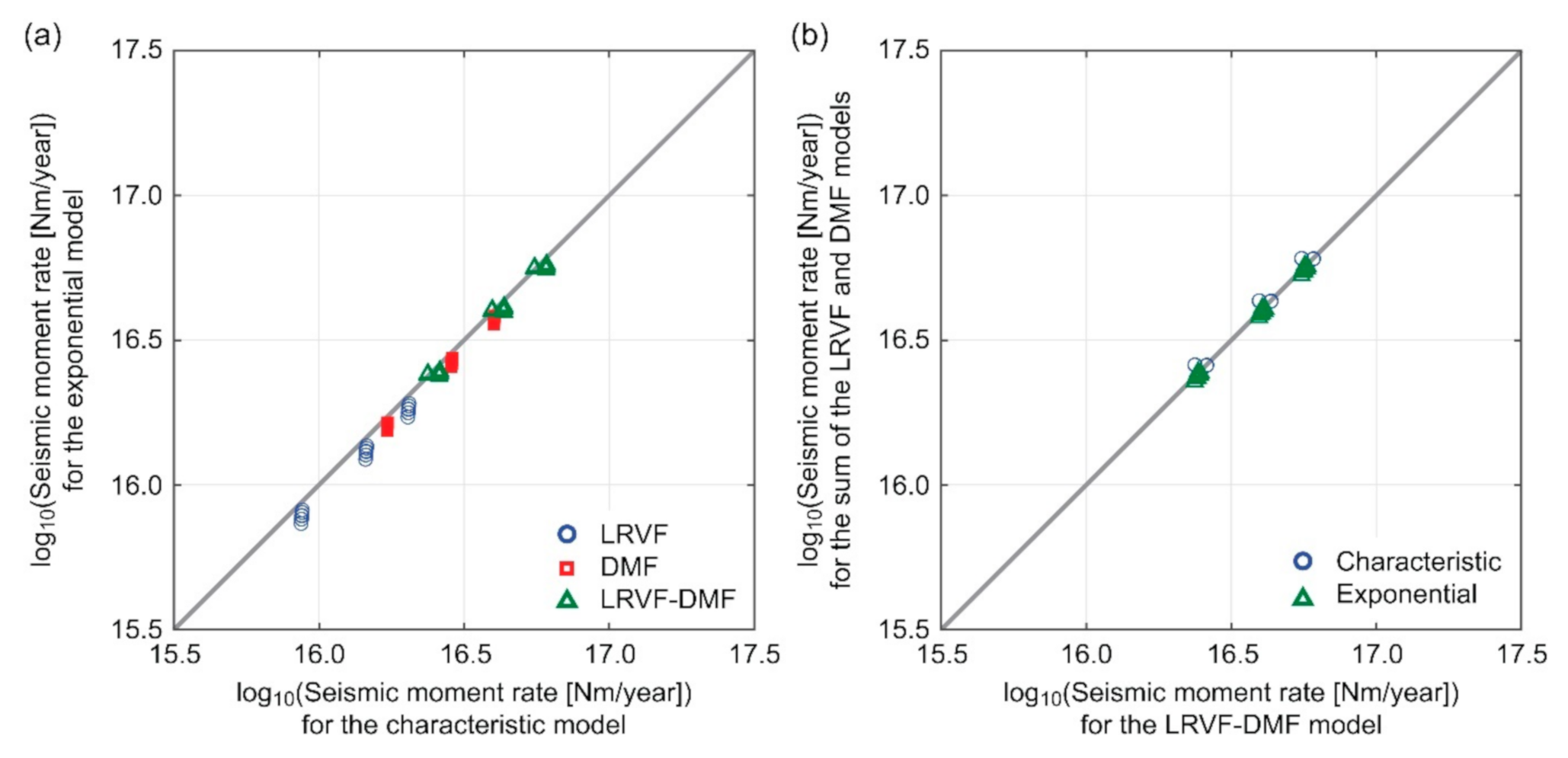
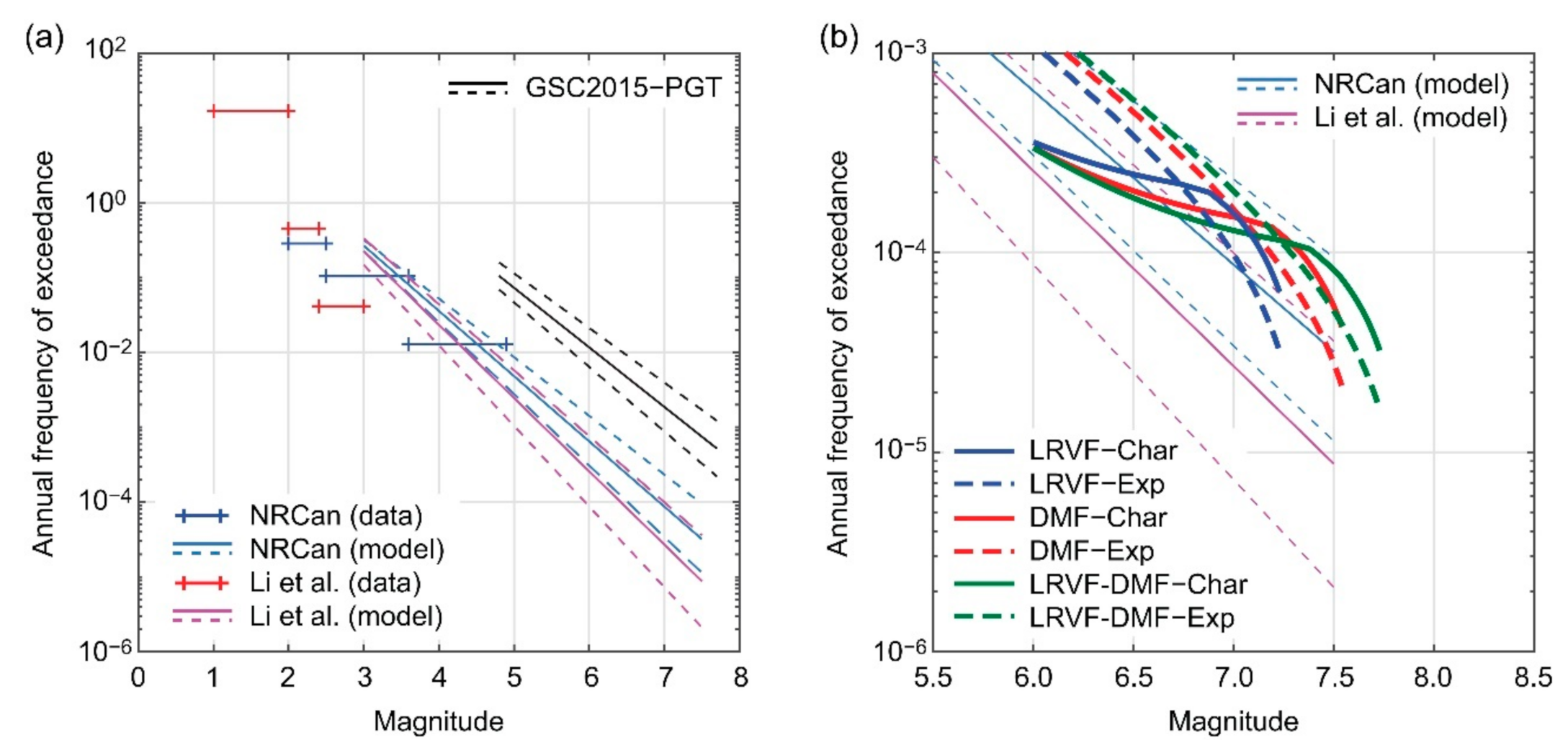
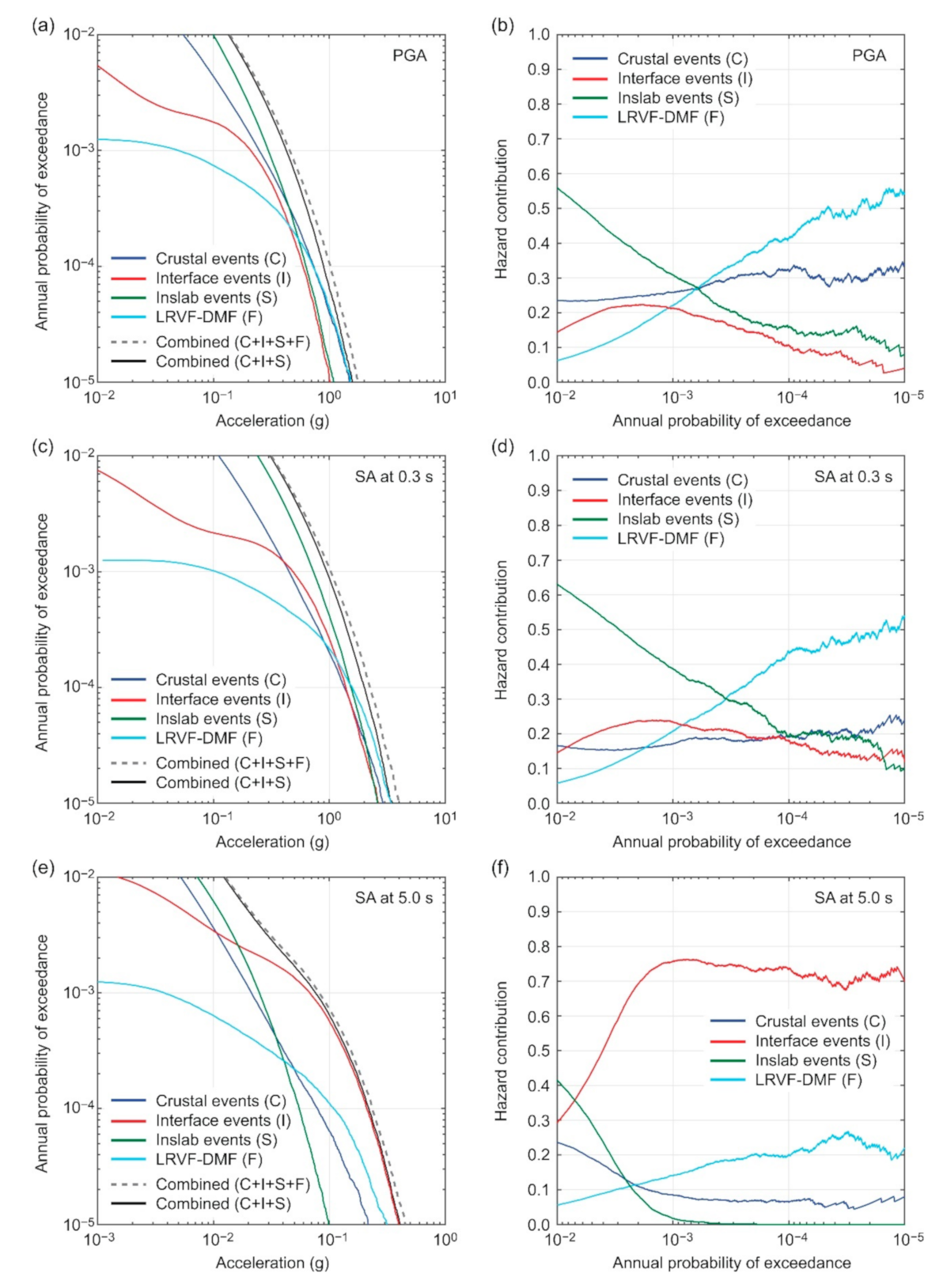
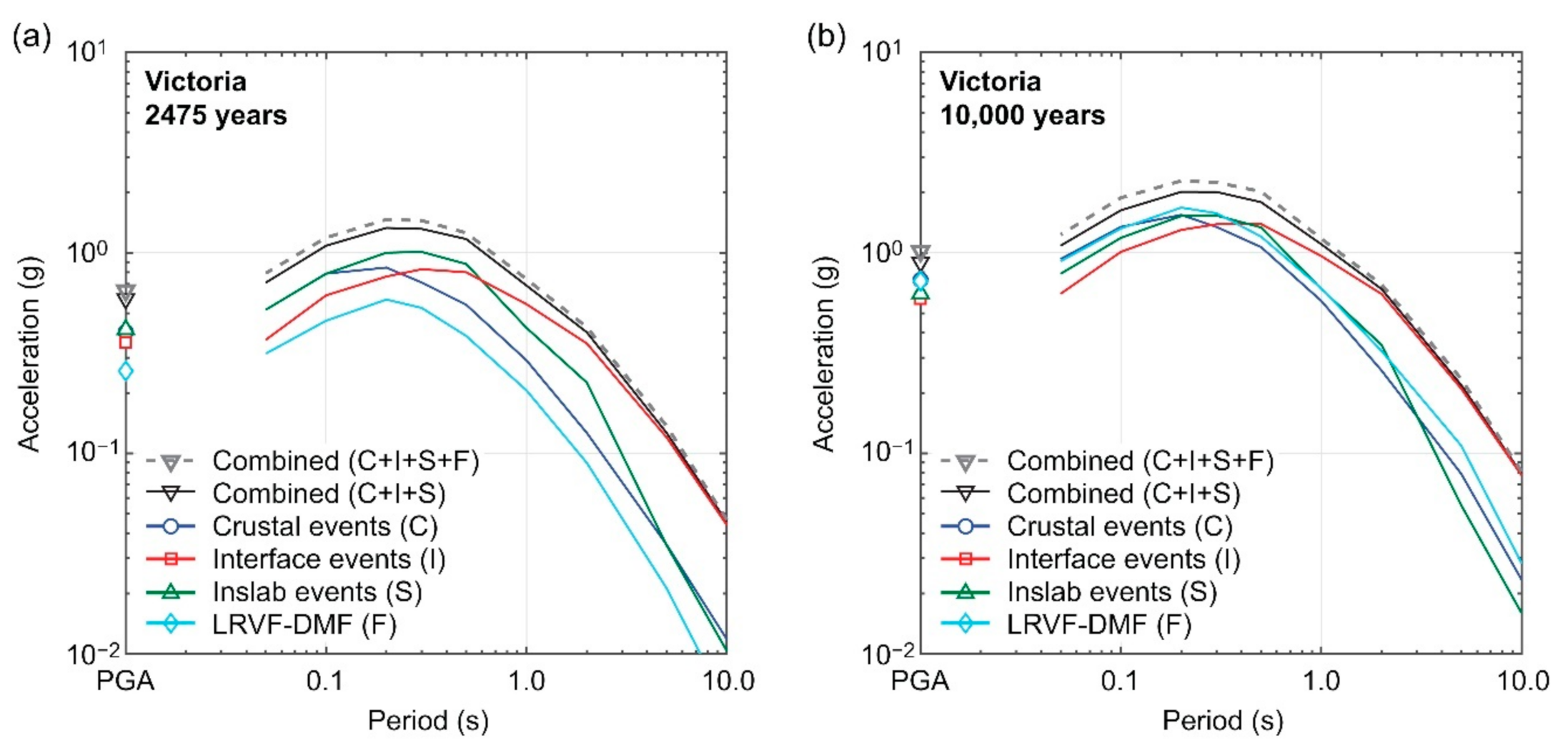
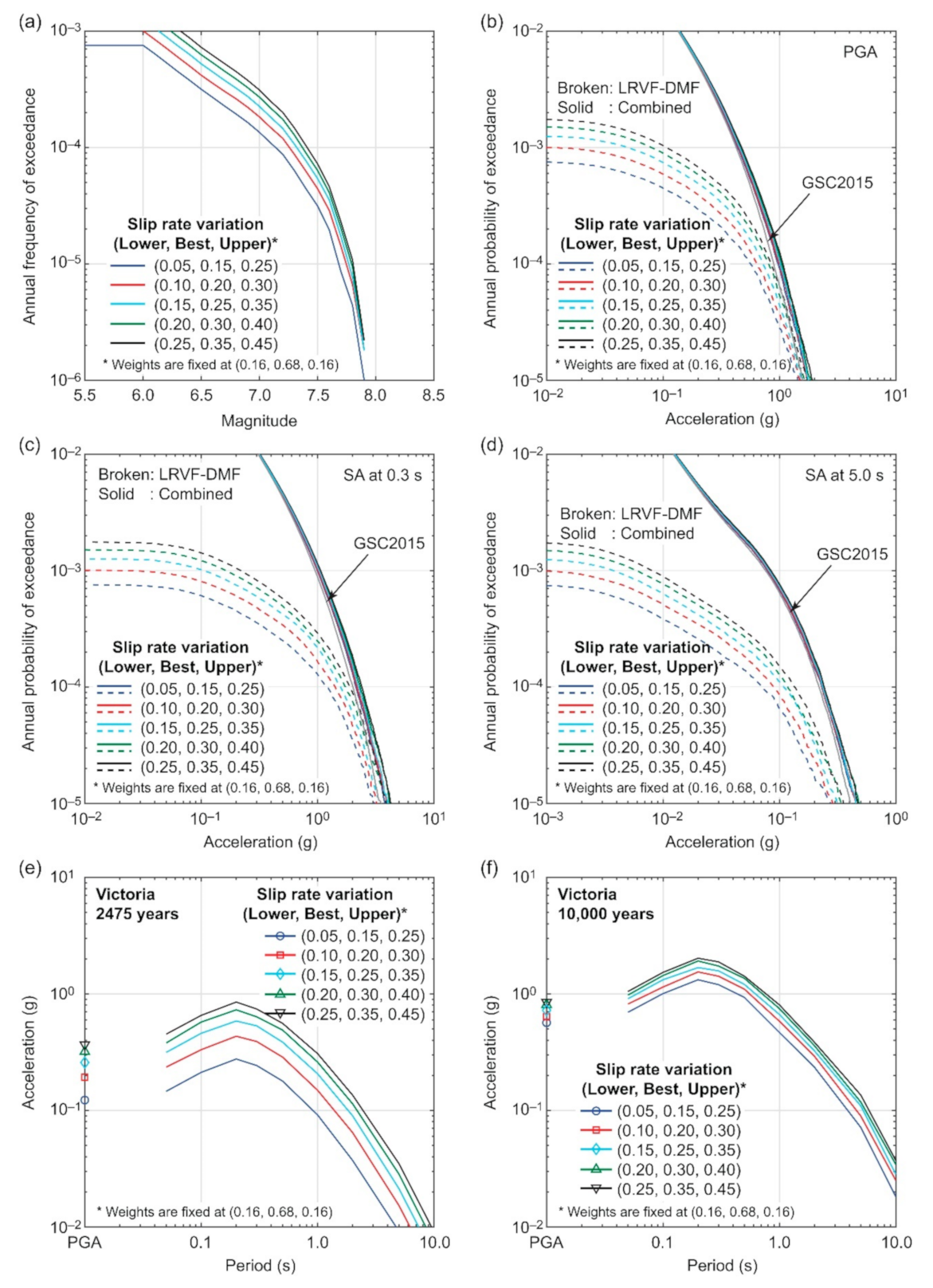
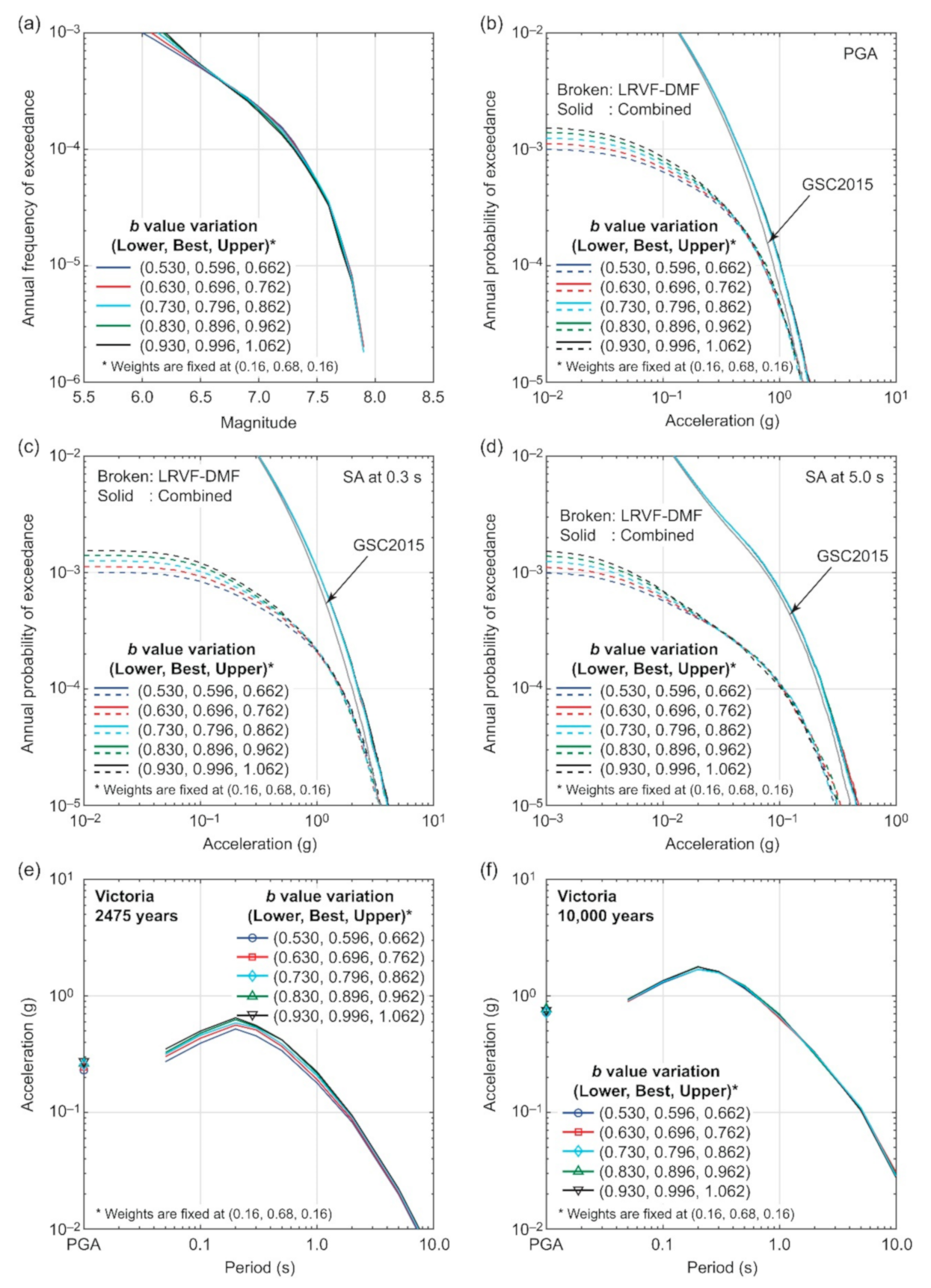
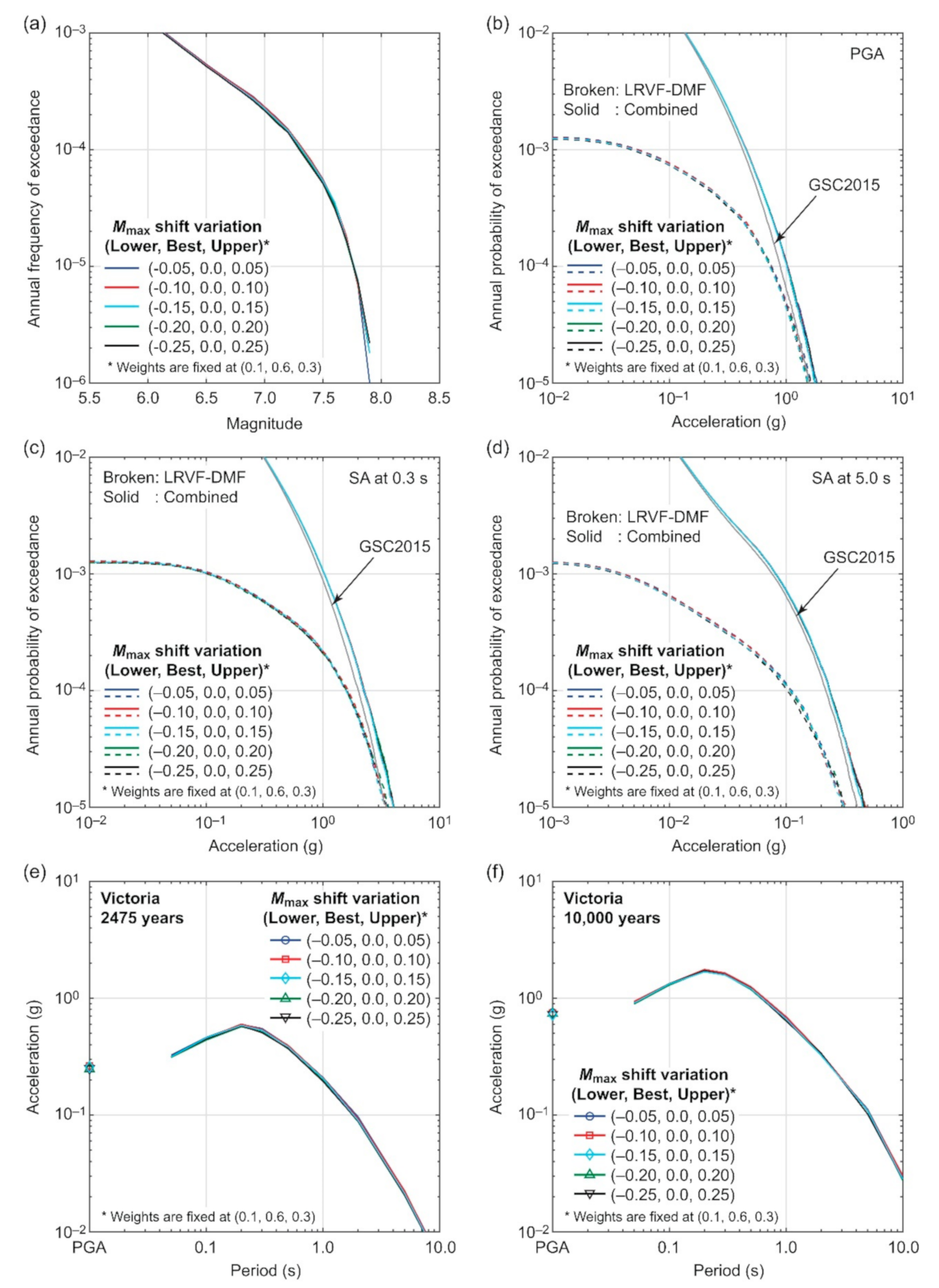
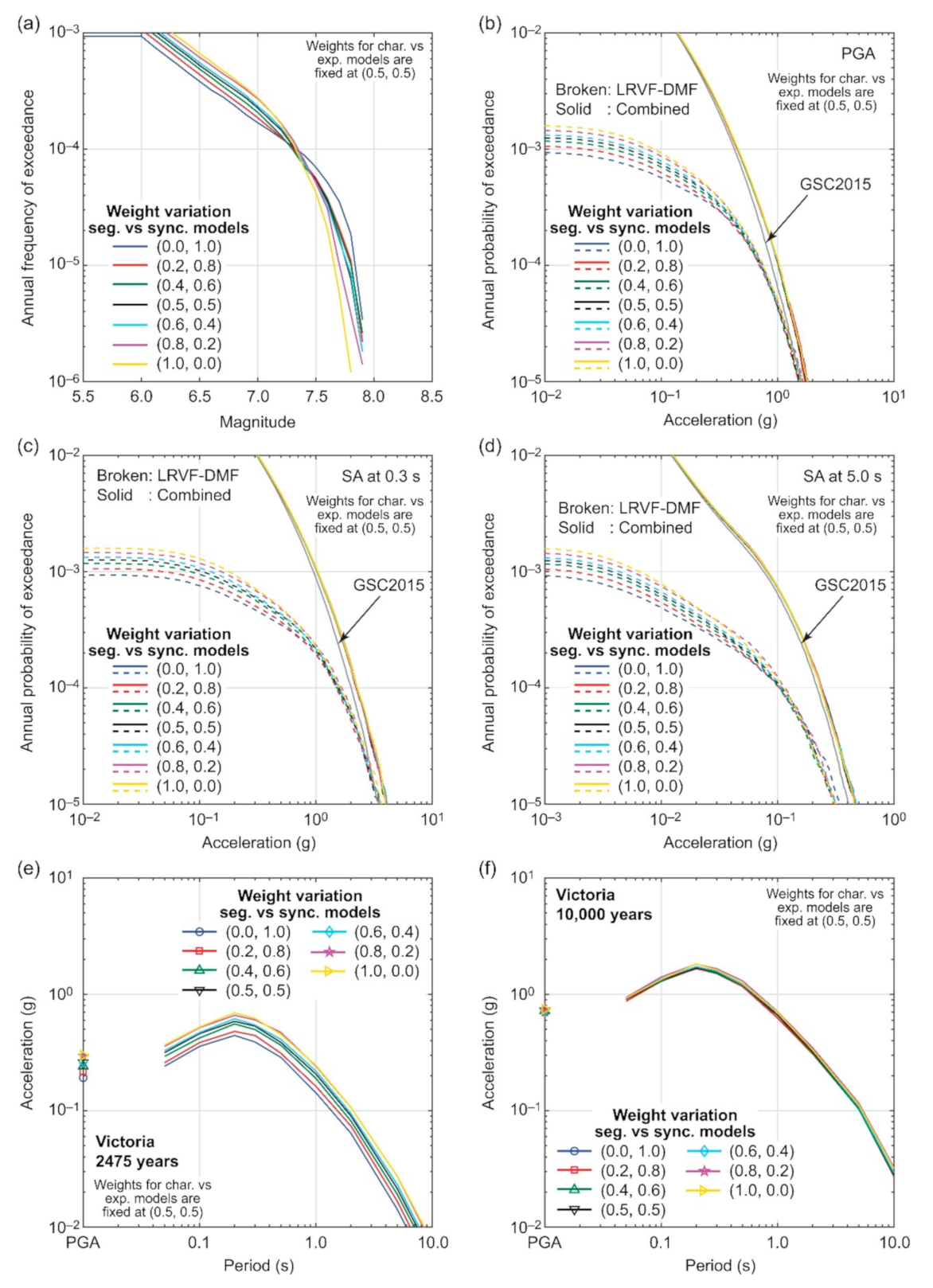

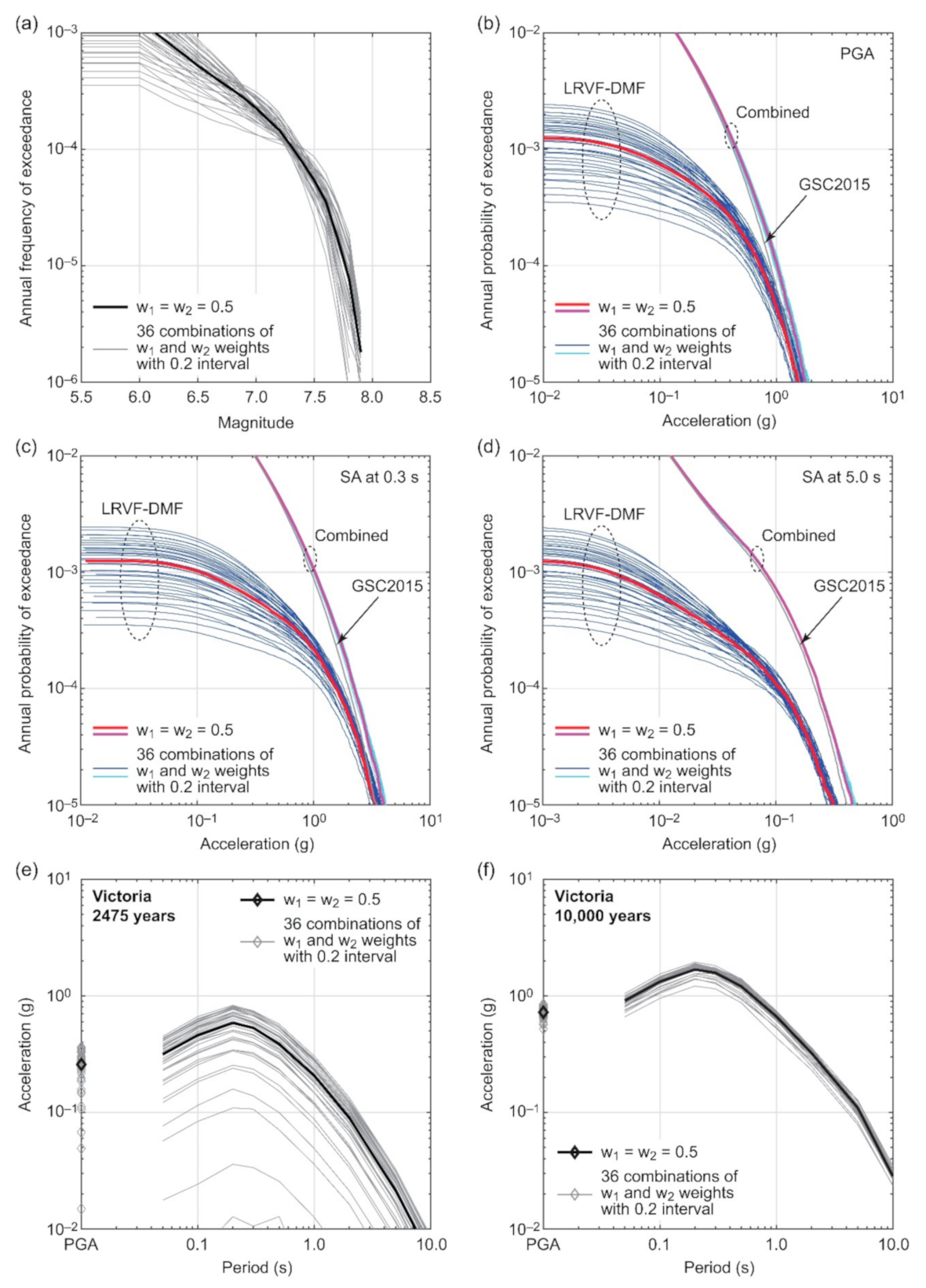
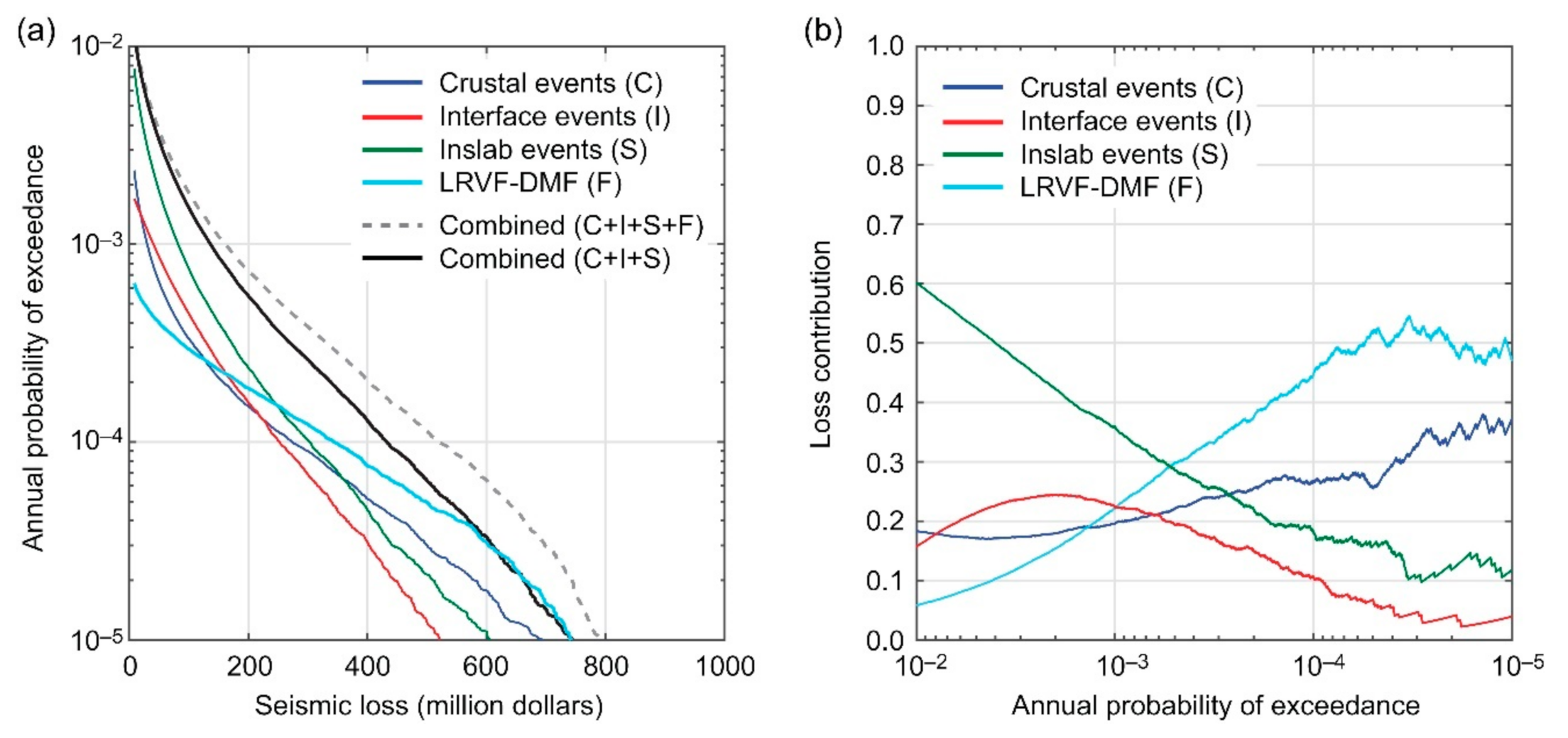

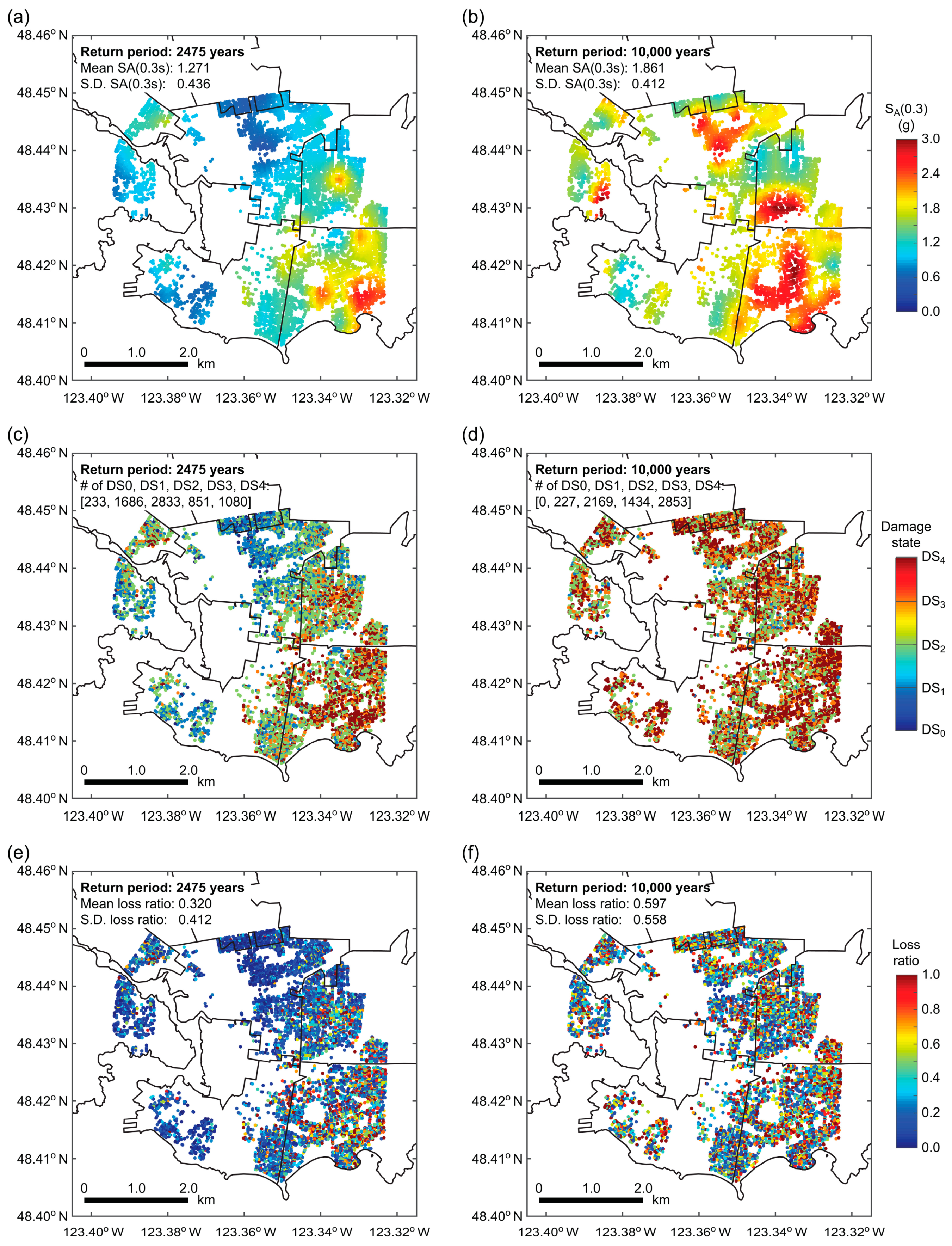
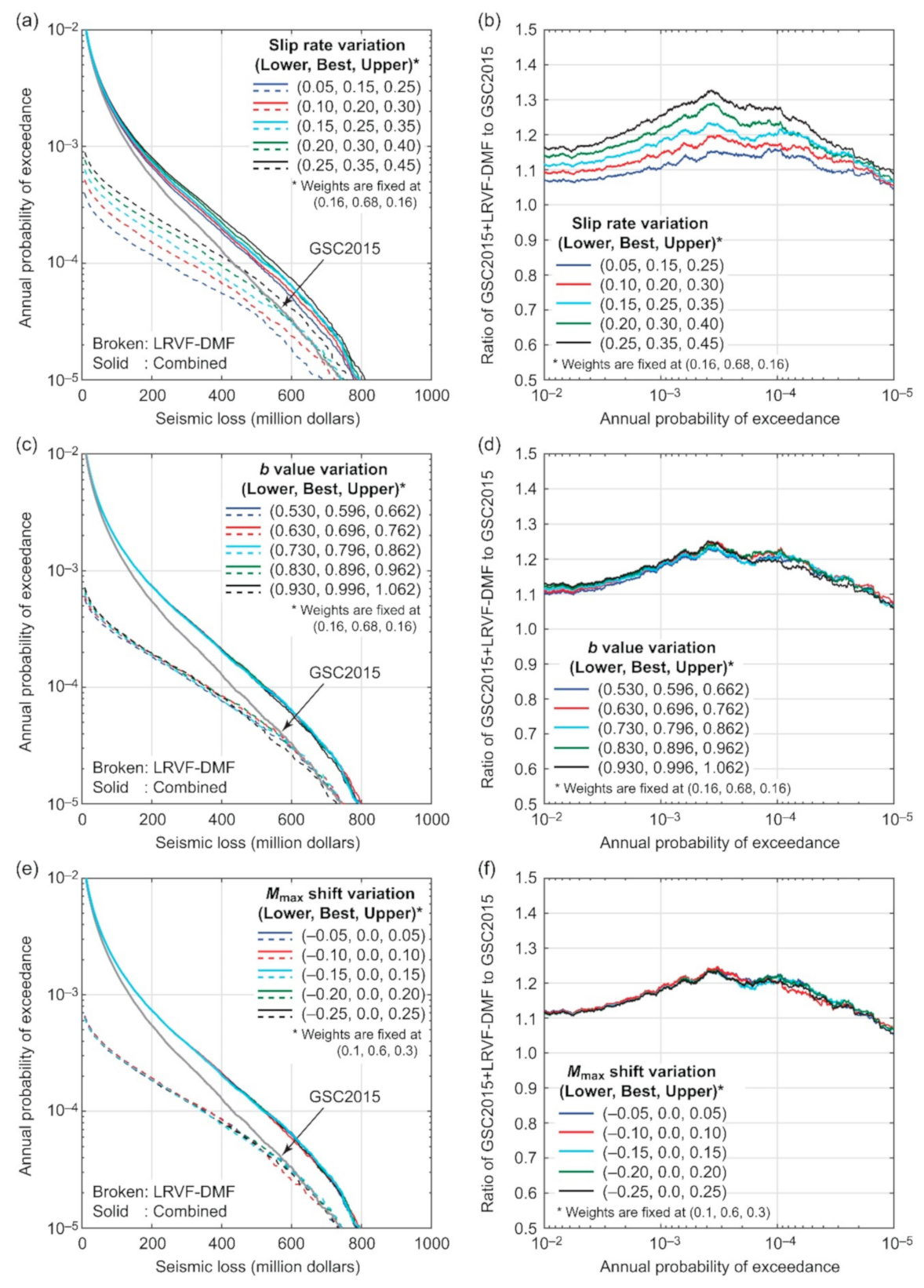

Publisher’s Note: MDPI stays neutral with regard to jurisdictional claims in published maps and institutional affiliations. |
© 2021 by the authors. Licensee MDPI, Basel, Switzerland. This article is an open access article distributed under the terms and conditions of the Creative Commons Attribution (CC BY) license (http://creativecommons.org/licenses/by/4.0/).
Share and Cite
Goda, K.; Sharipov, A. Fault-Source-Based Probabilistic Seismic Hazard and Risk Analysis for Victoria, British Columbia, Canada: A Case of the Leech River Valley Fault and Devil’s Mountain Fault System. Sustainability 2021, 13, 1440. https://doi.org/10.3390/su13031440
Goda K, Sharipov A. Fault-Source-Based Probabilistic Seismic Hazard and Risk Analysis for Victoria, British Columbia, Canada: A Case of the Leech River Valley Fault and Devil’s Mountain Fault System. Sustainability. 2021; 13(3):1440. https://doi.org/10.3390/su13031440
Chicago/Turabian StyleGoda, Katsuichiro, and Andrei Sharipov. 2021. "Fault-Source-Based Probabilistic Seismic Hazard and Risk Analysis for Victoria, British Columbia, Canada: A Case of the Leech River Valley Fault and Devil’s Mountain Fault System" Sustainability 13, no. 3: 1440. https://doi.org/10.3390/su13031440
APA StyleGoda, K., & Sharipov, A. (2021). Fault-Source-Based Probabilistic Seismic Hazard and Risk Analysis for Victoria, British Columbia, Canada: A Case of the Leech River Valley Fault and Devil’s Mountain Fault System. Sustainability, 13(3), 1440. https://doi.org/10.3390/su13031440






